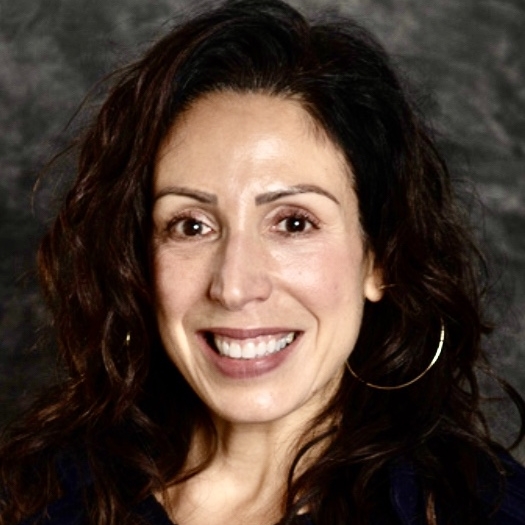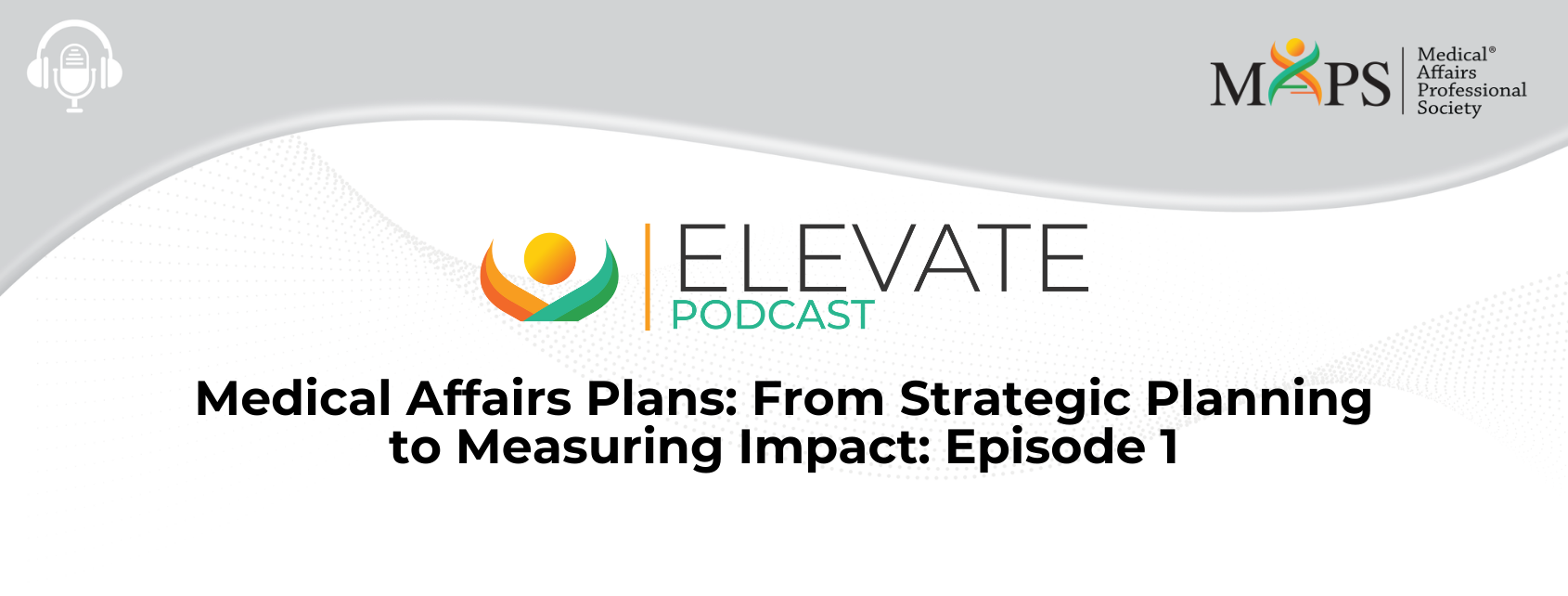The Series Podcast Objectives are:
- Understand how the medical affairs strategic planning process can drive decision making throughout the year
- Gain insight into the value medical affairs bring across an organization when an effective, collaborative, aligned medical strategy plan is developed
- Obtain a working knowledge of how cross-functional teams within medical affairs can reference strategic plans to inform decision making and assess impact of efforts

MODERATOR: Monica DeAbadal, MD, MBA/HSA

SPEAKER: Pete Piliero, MD

SPEAKER: Eileen K Sawyer PhD

SPEAKER: Anna Walz
Following is an automated transcription provided by otter.ai. Please excuse inaccuracies.
Monica de Abadal
Welcome to the Medical Affairs Professional Society’s Medical Strategy and Launch Excellence Focus Area Working Group’s four-episode podcast series Medical Affairs Plans: From Strategic Planning to Measuring Impact. The views expressed in these recording are those of the individuals and do not necessarily reflect the opinions of MAPS or the companies with which they are affiliated. This presentation is for informational purposes only and is not intended as legal or regulatory advice. This podcast focuses on the intellectual component of building the medical of our strategic plan. I am Monica de Abadal. Currently I serve as the VP Medical Excellence at Ipsen. In addition, I co lead the MAPS Medical Strategy and Launch Excellence Focus Area Working Group and have served as part of the MAPS media committee. This series podcast objectives are understand how the Medical Affairs strategic planning process can drive decision making throughout the year gain insight into the value Medical Affairs bring across an organization. When an effective collaborative online medical strategy plan is developed. Obtain a working knowledge of how cross functional teams within medical efforts conference strategy plans to inform decision making on the assess impact of efforts. In March 2020, at the MAPS annual meeting in Miami, a panel of Medical Affairs executives was convened to discuss MA strategic planning. Our panelists for the podcast are Peter Piliero MD. He is VP and head of Medical Affairs America GSK consumer healthcare, Eileen Sawyer PhD, she is Vice President for global Medical Affairs at UniQure and Anna Walz, CEO, MedEvoke. To begin Medical Affairs needs to deliver value. And that starts with building a strong Medical Affairs plan. Let’s listen.
Pete Piliero
We deliver valuable I talk more about value in the course of this session. but also throughout the meeting. The need is ultimately starts with the quality of the strategy that we develop our medical strategy, it’s really our opportunity to say how do we uniquely contribute to the success of the brand, of course, ultimately, to benefit the patient to make sure the right patients at the right drug at the right time. So how do we start this this intellectual component of strategy development and first is really understanding your situation or your therapeutic area or your disease state for your asset that you’re responsible for? And understanding what’s the current state? Where are the gaps out there? And that then moves into the medical strategy part, which is, where do we want to be? And what gaps do we want to fill? And importantly, what do we need to do to achieve those strategic imperatives. So the upfront work is really important. And we as medical need to do that work, nobody can just hand it to us. And it’s often done with a cross functional medical team led by each organization is a little different by the lead medical director or medical strategist, whether your organization calls that are really getting the contributions of all the functions in Medical Affairs, what is an approach a step by step approach that one can take and doing those first two, two steps of building a medical strategy. So first is leveraging the evidence to inform decision making and drive medical strategy. Again, it starts with understanding the environment that you are going to be working in and addressing. And we have lots of different sources of information. There’s the internal sources, which may be advisory boards that may be market research, even though we don’t do market research, per se, but that still could be valuable to us, the patient journey, but also I think one of the key two key areas of information that we could use to understand the landscape is what is medical information, hearing what kind of questions are coming in? And importantly, also what is the field, the medical team hearing in their scientific engagement, as well, you can do an external landscape evaluation sometimes that’s simply doing PubMed. But if we if we have the resources, we can often engage with the right partner to help us Understand the external landscape, sometimes they just have the tools that we don’t have the infrastructure to do that. Second step, use advanced analytics and proactively seek and uncover insights to inform strategy. So this, again, comes from all those data sources where you might be able to find an insight. So there’s a lot of data points that we all come in contact with that are, again, are met info or field or advisory boards spring. But not all of those pieces of data, you call observations actually turn out to be an insight to how do we navigate all of that information to find the insights that will then help us develop into a modifier strategy. And I think that’s where I see a lot of change happening right now, Medical Affairs, there are some workshops on insight mining here, I suggest you take advantage of those if you can, because I think we have to find a way to combine both the manual assessment of all those observations, along with using some AI type. technologies, like natural language processing help find those key insights that we can address. But we have a wealth of information that should inform our strategy. Next, it’s establishing a baseline of leading and lagging indicators to better quantify the impact of the strategy. So where do we want to go? What do we want to achieve? That should be you should know that from the get go as you develop the plan, and then backing going backwards. So what do we need to do to achieve those lagging indicators very importantly, to find those pieces, next is developing tactics. So all of that upfront work steps 123 is leads to the development of a tactical plan. And, as I mentioned earlier, there’s multiple functions within medical, and each often have their own tactical plan that roll up to an overall Medical Affairs plan. And so working as a medical leader, a medical strategy lead, it’s working at cross functional medical team, some some companies call it medicine, some team is really important as the quarterback of that medical team to develop both the strategic plan and the technical side. And then stratify internal and external stakeholders and develop communication and engagement tactics for their needs. So internal and external, we’ll start with the external, actually easier. And that’s really knowing your audience who isn’t out there that you will be engaging through whatever tactic it is, or steel, or whether it’s an advisory board or a publication, but needing to understand your audience. And what their needs are, what educational gaps they have will determine your tactical plan. And your engagement plan is for the MSL in the room. It’s about that pre engagement planning that you do today. I’m going to see Dr. So and so I know Dr. Solis, I was interested in this. And so I’m going to be ready to have that conversation. But I also know Dr. So and so can help inform our strategy, because of their backgrounds often ask them these questions. So preparation for engagement is really important. On the internal stakeholder side, sometimes that’s more challenging, right, because we have a lot of internal stakeholders we work with in Medical Affairs. And again, you have to try to know what resonates with them. Because they’re you’re looking for part of what you’re looking for is to get them to appreciate the value of what we deliver. So market access may have a very different need than marketing and understanding where they’re coming from and how to communicate with them so that they see the value of what we do is important. So again, it’s having that forethought to understand your audience.
Anna Walz
Who in your organization, Pete is leading this Medical Affairs strategic planning process?
Pete Piliero
Yeah, so we have a global medical director for each of our products or therapeutic areas. And, and they ultimately are the leader. But very importantly, we put a lot of sort of structure around how we do it. Having our own template, for example, that’s only part of it. Really reinforcing the need to have cross functional communication and partnership, particularly as the development of the strategy part. One should not be developing the strategy, medical strategy in isolation. There are ultimately a brand strategy, and there’s contributors and the three big ones are in medical market and market access. And I think all of our compliance colleagues have come a long way over the years. realized that having strategic alignment and discussing the strategy is a okay. So that that’s where we start with before we had people even break out into the functional tactical plan development, which is usually done in isolation once you have your mind stretch. So that’s great that the larger companies perspective, Eileen, I’m going to come to you to just get a completely opposite perspective on my small biotech was a beam therapy in development but not near commercialization. Sure. So I work for you to care, which is a small biotech developing gene therapies for rare disorders. I joined about four years ago or so, at which point I was the first Medical Affairs tire. So they knew they wanted Medical Affairs, they didn’t really know what Medical Affairs, they just knew that they needed it. And for a while I was about two years I was the only Medical Affairs person there. And this will proceeded any sort of commercial partners any market access. So my experience developing a medical plan at a company like Medicare is very different from what Pete described. It started with the process of understanding the landscape and the external stakeholder needs, as well as the internal stakeholder needs for what they needed for Medical Affairs overall. So at that stage, it was more about clinical developments, executive team, clinical operations and then forming a medical plan that met the needs both of the external community and what they were looking for, and was aligned internally at that time. And that that plan, as on the basis of the work on that program for the subsequent four years, it’s been a living document that we have continued to update each year and grow as the program.
Monica de Abadal
Thanks to our panelists for an engaging discussion and sharing their perspectives on ama strategic planning. This has been the first podcast in a series of Medical Affairs plans from strategic planning to measuring impact. In our second podcast, we will debate the timing of planning. If you’re not yet a MAPS member, and would like access to additional resources in this area. Please visit the MAPS website to start joining today at medical reference.org backslash membership



